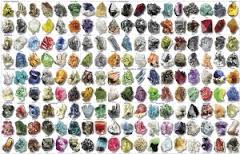 A mineral is a usually crystalline fabric, typically made of salts.
A mineral is a usually crystalline fabric, typically made of salts.
By shape, color, scratch color, melting behavior, etc. they can be recognized by a specialist.
There are different classifications for minerals in several groups with metals, phosphates, sulphates, nitrides, quartz, etc.
Many are just as vitamins important as trace elements, e.g. in mineral water.
In larger quantities, they are often unhealthy or toxic.
The International Mineralogical Association (IMA) recognizes in the mineralogy (in 2004) about 4,000 minerals.
About 150 are abundant, 50 occasionally, and the rest is rather rare.
To find suitable mineral commodities some knowledge of the strata helps.
Also to find or to make useful substances there are specializations.
To really find your way here is a study, or an elaborate hobby.
The ancient Greeks had prospectors that were looking for several rocks. These were sorted, crushed into powder, washed organics out to be rinsed and roasted over a wood fire with a lot of air.
"The function of an expert is not know better than the others,
but it is being wrong for more complex reasons.”
(David Butler)
" Expert: someone from out of town." (Paul A. Mars)
